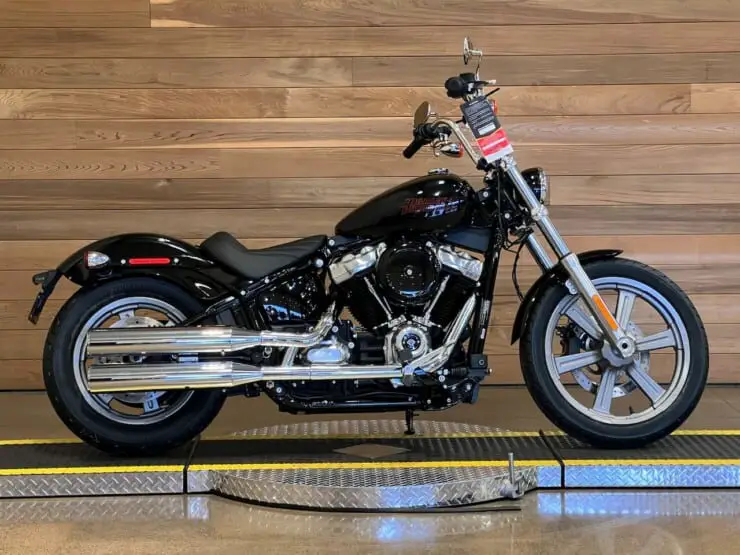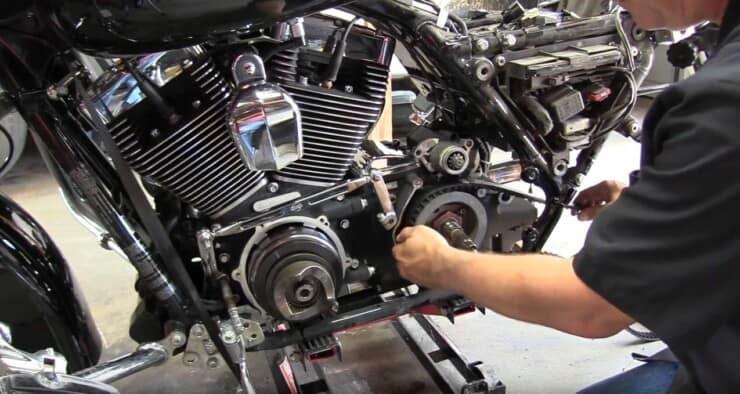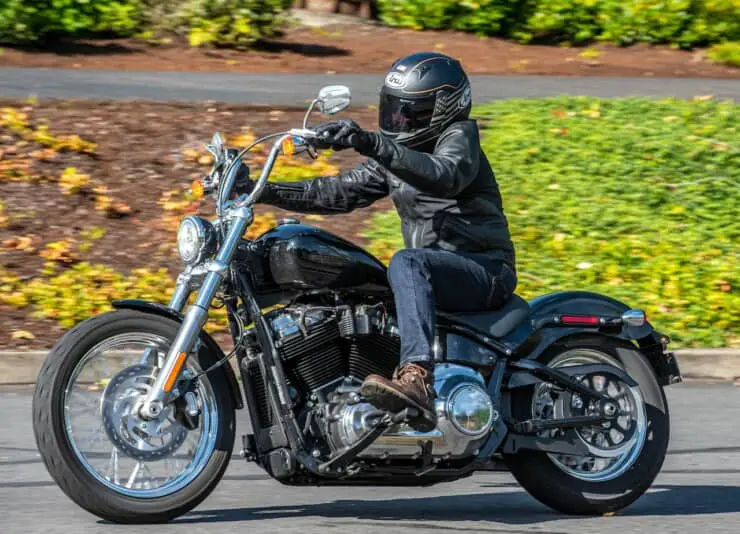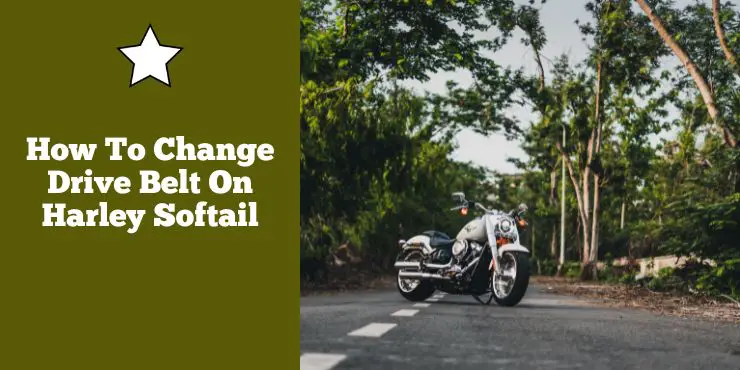Are you a Harley Softail owner? Are you looking for a comprehensive guide on how to change a drive belt? Look no further!
To change the drive belt on a Harley Softail, first remove the rear wheel and primary cover. Disconnect the old belt from the transmission pulley, install the new belt, and reassemble, ensuring proper tension is adjusted. This is a complex task; consult a service manual for detailed steps.
In this step-by-step guide, you will learn how to change drive belt on Harley Softail. By the end of this guide, you will have the peace of mind knowing you are equipped with the knowledge to keep your motorcycle running smooth and safe. So, let’s get started!
What does a drive belt do on a Harley-Davidson Softail?
The Harley-Davidson Softail is an iconic bike known for its powerful performance, timeless design, and immense comfort levels. Among its various components, the drive belt stands as an important element that plays a key role in the overall functionality of the motorcycle.
The drive belt or also referred to as the final drive belt or the primary drive belt is an important part of the powertrain system in a Harley-Davidson Softail. It is a reinforced flexible band made from synthetic rubber, reinforced with cords or steel errands. A drive belt is precisely engineered to provide the needed power transmission from the engine to the rear wheel.

The primary purpose of the drive belt on a Softail is to transfer power from the engine to the rear wheel. As the engine generates torque, it is channeled through the primary drive system, which consists of the clutch, primary chain, and compensator sprocket. From there on, the power will be transmitted to the drive belt, which ultimately transfers it to the rear wheel. This power transfer is important for propelling the bike forward and achieving desired speeds.
The drive belt system offers a smoother and quieter operation compared to traditional chain-driving systems. The belt’s design reduces noise and vibration, providing bikers with a more comfortable and enjoyable riding experience. Moreover, the drive belt needs less maintenance than a chain, which results in reduced downtime and increased overall reliability.
Tools and materials needed for changing the drive belt on a Softail
Maintaining your Harley-Davidson Softail in peak condition involves periodic inspections and occasional replacements of certain conditions. One such task that you need to follow involves changing the drive belt. Whether you are replacing a worn-out belt or upgrading to a new one, having the right tools and materials will be important for a smooth and successful drive belt change. Here are some of the tools and materials you will need for changing the drive belt on a Harley-Davidson Softail.
#1. A socket set
A comprehensive socket set with both metric and standard sizes will be indispensable for working on your Softail. Make sure it includes sockets of various sizes as you will need them for removing bolts and fasteners during the process.
#2. Torque wrench
For achieving the appropriate tightening torque specified by the manufacturer, a torque wrench will be a must-have tool. This will ensure that you don’t undertighten or overtighten bolts, promoting safety and preventing damage.
#3. Allen wrenches
Softail bikes often use Allen bolts in different sizes. Having a set of Allen wrenches will allow you to loosen and tighten these bolts with ease.
#4. Belt tension gauge
To ensure that the new drive belt is tensioned properly, a belt tension gauge will be vital. It will allow you to measure the correct tension needed for optimal performance and longevity.
#5. Belt tension adjusting tool
Some Softail models might require a specific belt tension adjusting tool, such as the Harley-Davidson Belt Tension Tool or a Harley drive belt repair kit. This tool helps facilitate the adjustment of the belt tension to match the manufacturer’s specifications.
#6. Pull locking tool
A pulley locking tool will be important for holding the drive pulley in place while loosening or tightening the pulley nut. This tool helps in preventing the pulley from rotating, which makes it easier to work on the drive belt.

Preparation before changing the drive belt
Changing the drive belt is an important maintenance task that needs proper preparation for ensuring a smooth and successful replacement. Adequate preparation will not only save time but it’ll also reduce the chances of errors or complications during the process. Here are some of the preparatory steps that must be carried out before changing the drive belt on a Harley-Davidson Softail.
#1. Consult the service manual
The service manual provided by Harley-Davidson is a rather invaluable resource when you’re performing maintenance tasks. Before starting the drive belt replacement, you must carefully review the relevant section of the owner’s manual pertaining to your Softail. You should familiarize yourself with the steps, diagrams, and specifications outlined. This will help ensure that you have a clear understanding of the process and follow the guidelines accurately.
#2. Set up a clean and well-lit workspace
Creating an organized and clean workspace will be important for a smooth drive belt replacement. Begin by choosing a well-lit area where you have ample space to work around the bike. Clear the workspace of any clutter or obstructions that might hinder your movement. Lay out a clean and soft surface, such as a rubber mat or blanket, to place parts and tools on, ensuring they don’t get damaged or scratched.
#3. Secure your bike
Before starting the work, you should ensure that your bike is properly secured to prevent any accidents or damage. Make use of a motorcycle lift or center stand for elevating the rear wheel off the ground. If a lift or center stand isn’t available, you can use sturdy jack stands placed under the frame for supporting the bike securely. Make sure that the bike is stable and won’t tip over during the drive belt change process.
#4. Remove obstructions
Identify any parts or accessories that might hinder access to the drive belt or related components. Remove any saddlebags, seats, or any other components that might interfere with your ability to work on the primary drive system. Clearing these obstructions will provide you with the space needed to carry out the change smoothly.
How to change drive belt on Harley Softail: Remove the old drive belt
Removing the old drive belt from your Softail is an important step for changing the old one. Properly executing this process will ensure a smooth and successful drive belt change. Here are the steps involved with removing the old drive belt from your Harley-Davidson Softail.
Step 1: Loosen the drive belt adjuster
The drive belt adjuster is typically located on the rear section of your Softail near the rear wheel. It is a threaded rod or bolt that allows you to adjust the tension of your drive belt. Look for a locking mechanism near the drive belt adjuster. This mechanism will prevent the adjuster from rotating once the proper tension is achieved.
Depending on your Harley-Davidson Softail model, the locking mechanism can be a lock nut or a locking plate. Use the appropriate tools for releasing the lock nut or loosening the locking plate, allowing the drive belt adjuster to rotate freely.
Using a suitable wrench or socket, rotate the drive belt adjuster counterclockwise. This action will increase the slack in the dive belt allowing for its removal.
Step 2: Remove the drive belt
Locate the belt tension inspection window on the Harley-Davidson Softail’s primary drive cover. This window will allow you to assess the tension of the drive belt. Look through the inspection window and observe the position of the belt tension indicator. This indicator will provide a visual reference for proper belt tension.
With the drive belt adjuster loosened, the belt tension will decrease. You must continue rotating the drive belt adjuster until the belt tension indicator falls within the acceptable range specified by the manufacturer. For facilitating the drive belt removal, it’ll be necessary to remove the rear wheel. For that, you should refer to your bike’s owner’s manual for detailed instructions on removing the rear wheel.
Before removing the old drive belt, you should carefully observe and note the routing of the belt around the pulleys. This will help during the installation of the new drive belt. With the new rear wheel removed, you should gently slide the old drive belt off the rear pulley and off the front pulley. Take care that you don’t damage or nick the belt during this process.

How to change drive belt on Harley Softail: Install the new drive belt
Installing a new drive belt will be an important part of maintaining the performance and reliability of your Softail. Properly installing the new drive belt will help you change the drive belt safely and effectively. Here are the steps you need to follow for installing a new drive belt on your Harley-Davidson Softail.
Step 1: Inspect the new drive belt
First, you’ll need to unpack the new drive belt carefully from its packaging. Take care that you don’t damage or twist it during the process. Inspect the drive belt for any visible signs of damage or defects. Ensure that your new drive belt is the correct one for your specific Softail model. Cross-reference the part number and specifications with the information mentioned in your bike’s owner’s manual or consult with a reputable Harley-Davidson dealer.
Then, you should measure the width, pitch, and number of teeth on the new drive belt to confirm that they match the manufacturer’s specifications for your Softail model. Inspect the new drive belt for any imperfections, such as cuts, fraying, or signs of excessive wear. If you are noticing any defects, you shouldn’t proceed with the installation and contact the supplier for a replacement.
Step 2: Install the new drive belt
If you have removed the rear wheel during the drive belt change process, now will be the ideal time to reinstall it. Follow the instructions mentioned in your Harley-Davidson Softail’s owner’s manual for proper rear wheel installation.
Referencing the notes you made during the removal of the old drive belt, you should route the new drive belt around the front and rear pulleys. Make sure that the belt follows the correct path and is properly seated on the pulleys.
Then, you will need to observe the belt tension indicator through the inspection window on the primary drive cover. Make sure that the belt tension falls within the acceptable range as specified by the manufacturer. If needed, make use of a belt tension gauge to fine-tune the tension.
If the belt tension isn’t within the specified range, you might have to adjust the drive belt tension using the drive belt adjuster. Follow the instructions mentioned in Softail’s service manual for making the necessary adjustments.
Once the belt tension is adjusted properly, you should secure the drive belt adjuster in its final position to get the Harley final drive belt. Make use of the appropriate locking mechanism, such as a lock nut or locking plate for preventing the adjuster from rotating unintentionally.
Double-check the alignment of the new drive belt with the pulleys. Make sure that the belt runs smoothly and doesn’t rub against any other components. Make any necessary adjustments for achieving proper alignment. Inspect the entire drive belt system, including the pulley, tensioner, and adjuster to make sure everything is in place and properly seated. Check for any signs of interference or abnormal wear.
How to change drive belt on Harley Softail: Finalize the installation
After you have successfully changed the drive belt on your Harley-Davidson Softail, it’ll be important to make sure that the drive belt adjuster is tightened correctly and that the belt is properly fitted. Proper tension and alignment will be essential for the optimal performance and longevity of the drive belt. Here are the steps you need to follow to finalize the installation of the new drive belt on your Softail.
Step 1: Tighten the drive belt adjuster
First, you need to locate the drive belt adjuster. Identify the drive belt adjuster on your Softail. It is typically located on the rear section of your bike near the rear wheel. Referencing your Softail’s owner’s manual, determine the initial tension specification for the drive belt. This specification will serve as a starting point for the Harley primary belt drive adjustment.
By making use of appropriate tools, rotate the drive belt adjuster clockwise for increasing the tension. Gradually tighten the adjuster while periodically checking the belt tension. Utilize a belt tension gauge for measuring the tension of the drive belt. Refer to the owner’s manual for the specific tension range.
Continue rotating the drive belt adjuster and measuring the tension until the belt falls within the acceptable range specified by the manufacturer. Be cautious that you don’t overtighten the belt as excessive tension could result in premature wear or other issues.
Step 2: Check for proper fit
Examine the alignment of the drive belt with the front and rear pulleys. Make sure that the belt runs smoothly along the pulleys without rubbing against any other components. Adjust the belt alignment if needed by slightly loosening the drive belt adjuster and making the needed corrections.
With the bike on a level surface and the rear wheel properly installed, you must confirm that the drive belt maintains adequate clearance from other components, such as the swingarm, transmission, and pulley covers. Make sure that there is no contact or interference during the operation.
Carefully inspect the pulleys and tensioner for any signs of abnormal wear, damage, or misalignment. Make sure that all bolts and fasteners associated with the drive belt systems are tightened securely.
Take a brief test ride for assessing the performance of the drive belt. Listen for any unusual noises or vibrations and pay attention to the overall smoothness of the bike’s operation. If necessary, you should make minor adjustments to the drive belt tension to achieve optimal performance and comfort.
Symptoms that you need to replace the drive belt
The drive belt is a critical component of a Harley-Davidson Softail that transfers power from the engine to the rear wheel. Over time, the drive belt might wear out, stretch, or become damaged, affecting the performance and safety of your bike. It is important to recognize the signs that indicate the need to change the drive belt. Here are some of the common symptoms that suggest it is time to replace the drive belt on your Harley-Davidson Softail.
#1. Visible wear and damage
Inspect the drive belt for visible signs of wear, such as fraying, cracking, or missing teeth. These indicators are clear indications that the drive belt has reached the end of its lifespan and requires replacement. Moreover, if you notice any cuts or chunks missing from the belt, it’ll be important to replace it promptly to avoid potential belt failure.
#2. Excessive slack or tension
The drive belt needs to have the correct tension for optimal performance. If you notice excessive slack or sag in the drive belt, it might be a sign that it has stretched beyond its recommended limits. On the other hand, if the drive belt feels excessively tight or if you’re hearing squealing or grinding noises during operation, it might be a sign of over-tensioning. Both cases necessitate a drive belt replacement to restore proper tension and prevent further damage.
#3. Uneven wear patterns
Inspect the drive belt for uneven wear patterns or “cupping”. This will refer to indentations or irregularities on the surface of the belt. Cupping can occur because of misalignment or improper tension, causing accelerated wear and reducing the belt’s overall lifespan. If you observe such wear patterns, it is advised to replace the drive belt and address any underlying issues that contributed to the uneven wear.
#4. Reduced performance and sluggish acceleration
A worn or damaged drive belt can negatively impact the performance of your Harley-Davidson Softail. If you’re noticing a decrease in acceleration, a loss of power, or sluggishness when accelerating, it might be a sign that the drive belt is worn out or slipping. A worn drive belt cannot efficiently transfer power from the engine to the rear wheel, resulting in reduced performance. Replacing the drive belt can help restore optimal power delivery and enhance overall performance.
#5. Excessive vibration or noise
Unusual vibrations or excessive noise during operation could be indicative of drive belt issues. If you’re experiencing increased vibrations or a rattling sound coming from the drive belt area, it could suggest that the drive belt has become loose, worn, or misaligned. Addressing these symptoms promptly by replacing the drive belt can help restore a smooth and quiet ride.
#6. Mileage and maintenance history
The drive belt’s lifespan can vary depending on several factors, including riding conditions, maintenance practices, and overall mileage. As a general guideline, it is recommended that you should change the drive belt between 20,000 and 50,000 miles or as specified by the manufacturer. If your Softail has surpassed the recommended mileage and hasn’t had a drive belt replacement, it is advised that you should consider replacing it as a part of routine maintenance.
FAQs
What tools are needed to change a drive belt on a Harley Softail?
Changing a drive belt on a Harley Softail requires a few basic tools, including a wrench, tire iron, screwdriver, and a drive belt removal tool. You will also need a new drive belt and a replacement tensioner, if necessary.
What is the process for changing a drive belt on a Harley Softail?
The process for changing a drive belt on a Harley Softail involves removing the old drive belt, installing the new drive belt, and adjusting the tensioner. It is important to follow the manufacturer’s instructions for the exact steps for your model of bike.
What should I do if the drive belt is noisy or slipping?
If the drive belt is noisy or slipping, it may need to be replaced. Check the belt for signs of wear, such as fraying or cracking, and adjust the tensioner if necessary. If the belt is still noisy or slipping, it should be replaced.

